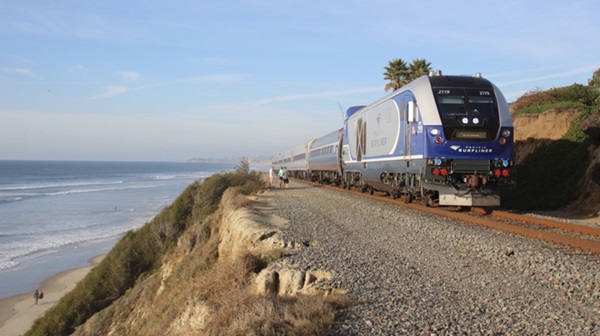
DEL MAR, Calif. — The California Coastal Commission has approved the San Diego Association of Governments’ stabilization plans for the Del Mar Bluffs, despite objections to parts of the project from the North County Transit District as well as residents.
The San Diego Union reports that at a Wednesday, June 8, meeting, the commission unanimously approved the three-year, $68 million plan for a seawall, concrete-and-steel piles, and concrete drains to protect the rail line — used by Amtrak, NCTD Coaster commuter trains, and BNSF freight traffic — that sits atop the bluffs.
The City of Del Mar objected to the plan, citing “serious concerns about the adverse effects of seawalls,” in a letter approved by the city council earlier in the week [see “Del Mar to ask coastal agency to slow rail-line stabilization plans,” Trains News Wire, June 8, 2022].
The transit district objected to the plan because SANDAG, the regional planning agency, has included a mile-long bluff-top trail, pedestrian rail crossing, and beach access by ramp or stairs to the project, at the request of the coastal commission, to offset the loss of public beach because of the seawall project. NCTD Executive Director Matt Tucker told the commission those aspects “impose significant obligations and costs well beyond the safety project” that will take away from transit agency investments elsewhere.
While the commission generally opposes seawalls, commissioners said they had worked with SANDAG to find a solution, with commission member Paloma Aguierre saying, “I cannot fathom thinking about a train full of people falling into the ocean.”














At what point will the City of Del Mar, SANDAG, and the State of California wise-up and direct the conversation to the concept of equity?
New York’s governor is already pushing for $7-$8 Billion for re-creating Penn Station in NYC; the OIG did not hesitate to call out Amtrak for its inability to even plan and supervise the massive financial costs for the NEC.
On that basis, we cannot tolerate such an open-ended funding focused on the NEC at the expense of the rest of the nation. Instead, the Del Mar issue is deserving of federal funding support to alleviate the encroachment of water to weaken the right-of-way.
Penn Station handles more than 70M passengers a year, from multiple states (New Jersey, Pennsylvania, Connecticut, etc.). Not sure equity would favor Del Mar with these numbers.
Surfliner and Coaster combined handle just over a million passenger a year, all within California.
Not sure how equity would favor Del Mar.
Some great comments, I can only assume that the City of Del Mar and its residents really want is someone to pay for the billion dollar tunnel plan that would take the tracks off the bluff. So Its nice to see California Coast Commission greenlight and agree with a plan that is reasonable. Let the city, county and even the state fund a tunnel in a process like any other infrastructure project would be instead of these baseless fights that as a few have noted already will most likely result in baseless litigation.
..
The other thought. Reminds me a lot of Chicago Suburbs claims that they need 9 billion to offset, mitigate increase rail traffic because of a CPKS merger.
..
The California Coastal Commission has been the subject of several land use takings cases, some of which went all the way to the Supreme Court. They lost in those cases because they went too far. Their ruling indicates they have learned their lessons well.
“In Nollan v. California Coastal Commission, 483 U.S. 825 (1987), the United States Supreme Court reviewed a regulation under which the California Coastal Commission required that an offer to dedicate a lateral public easement along the Nollans’ beachfront lot be recorded on the chain of title to the property as a condition of approval of a permit to demolish an existing bungalow and replace it with a three-bedroom house. The Coastal Commission had asserted that the public-easement condition was imposed to promote the legitimate state interest of diminishing the “blockage of the view of the ocean” caused by construction of the larger house. The Court held that in evaluating such claims, it must be determined whether an “essential nexus” exists between a legitimate state interest and the permit condition.[1]”
A good lawyer would tell potential plaintiffs they have no case. SANDAG went above and beyond to accommodate the needs of the local community.
You could also cite the Dolan v Tigard case as well.
“Dolan v. City of Tigard, 512 U.S. 374 (1994), more commonly Dolan v. Tigard, is a United States Supreme Court case.[1] It is a landmark case regarding the practice of zoning and property rights, and has served to establish limits on the ability of cities and other government agencies to use zoning and land-use regulations to compel property owners to make unrelated public improvements as a condition to getting zoning approval, citing the violation of the Fifth Amendment’s Takings Clause.[2][3]”
An ambulance chaser lawyer will take the case, since they get paid either way.
They’ve won more cases than they’ve lost because of the way the California legislature set up the Commission when writing the law. The cases you sited happened to be case specific and any similar cases would need to be litigated as well. As for the comment from the City of Del Mar. ““serious concerns about the adverse effects of seawalls,” that’s a complete load of BS, all you have to do is look at all the PROPERLY designed, located and built seawalls around the world to see that’s just a bunch of smoke. If they have questions about how to build a proper seawall…just look at the new design they’re using in Dalish in the U.K..
This is at least a temporary win for the good guys.
Guessing the first lawsuit to stop it will be filed by the end of the day, sigh.